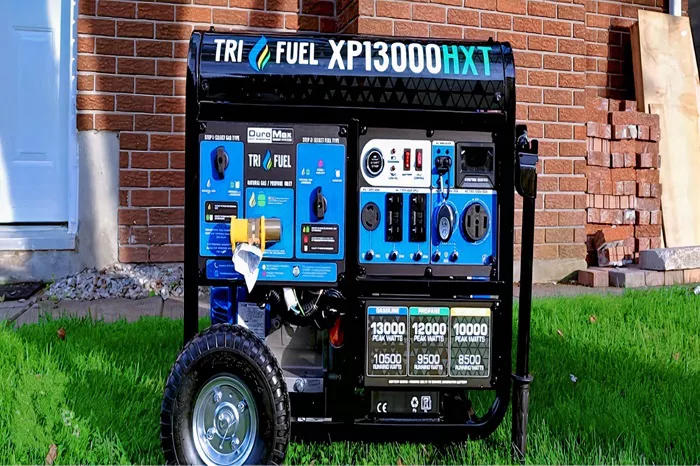When preparing for a power outage or considering an off-grid lifestyle, determining the appropriate generator size to run your entire home is a critical decision. Understanding wattage requirements, including both running and starting watts, is key to ensuring you select a generator capable of supporting your household’s electrical demands. Below is a detailed guide to help you navigate the complexities of choosing the right generator size for your home.
Understanding Wattage Requirements
Before purchasing a generator, it’s essential to understand the two main types of wattage:
Running vs. Starting Watts
Running Watts: These are the continuous watts required to keep appliances and systems operating over time. For example, once a refrigerator or light has started, the wattage needed to keep it running is its running wattage.
Starting Watts: Also known as surge watts, these are the additional power needed to start appliances with electric motors, such as refrigerators, air conditioners, and pumps. Starting watts can be significantly higher than running watts, making it crucial to account for both types of wattage when choosing a generator.
Why It Matters
When calculating generator capacity, both running and starting watts must be considered to ensure the generator can handle the startup surge without causing damage or tripping a breaker.
Total Wattage Calculation
To determine how many watts your home needs, start by making a list of all essential appliances and systems you want to power during an outage. Then, calculate their total wattage by following these steps:
List all appliances: Identify all essential appliances (refrigerator, lights, air conditioning, etc.) that must be powered.
Check wattage specifications: For each appliance, check the manufacturer’s specifications for both running and starting wattage. If you can’t find this, approximate values can often be found online.
Add up the wattage: Sum up the running wattages of all appliances. Then, for appliances with motors (e.g., air conditioning units), add their starting wattages to the total.
Consider peak usage: Add a safety margin (usually 20-30%) to ensure the generator can handle any unexpected surges.
Typical Wattage Needs for a Whole House
Average Home Requirements
On average, a home requires between 5,000 to 7,500 watts to run essential appliances and systems. This will typically cover lighting, a refrigerator, some basic kitchen appliances, and smaller heating or cooling systems.
Larger Homes
Larger homes with more space and appliances, including multiple HVAC units or advanced entertainment systems, may require a generator in the 10,000 to 20,000-watt range. This range ensures you can power larger systems like multiple air conditioners, electric ovens, and well pumps.
Key Appliances and Systems
Certain appliances and systems require significantly more power to operate. Here are the typical wattage requirements for some common household items:
Essential Appliances
Refrigerator: 600-800 running watts, 1,000-1,200 starting watts
Microwave: 1,000-1,500 running watts
Electric Stove/Oven: 2,000-5,000 running watts
Lights: 50-200 running watts per light bulb (depending on wattage)
Washing Machine: 500-1,000 running watts, 1,500-2,000 starting watts
Dishwasher: 1,200-1,500 running watts
Coffee Maker: 800-1,200 running watts
HVAC Systems
Air Conditioning Unit: 2,000-4,000 running watts, 3,000-6,000 starting watts
Furnace Blower: 400-1,000 running watts
Well Pump: 1,000-1,500 running watts, 1,500-2,500 starting watts
Since HVAC systems typically consume more energy, they are often one of the most important factors to consider when calculating generator capacity.
Types of Generators
Generators fall into two primary categories, each with its benefits and limitations:
Portable Generators
Portable generators are designed for temporary use and are typically smaller, with wattage capacities ranging from 1,000 to 7,500 watts. They are ideal for powering essential appliances like refrigerators, lights, and a few small electronics. However, they may not be powerful enough to run an entire household, especially larger homes with central heating and cooling systems.
Pros: Portable, affordable, can be moved as needed.
Cons: Limited wattage, manual setup, fuel-dependent.
Standby Generators
Standby generators are permanently installed and automatically kick in when the power goes out. These generators typically have much higher wattage capacities (ranging from 7,500 to 20,000 watts or more) and are capable of powering an entire house, including HVAC systems, multiple appliances, and high-demand electrical devices.
Pros: High wattage capacity, automatic power transfer, permanent installation.
Cons: Higher initial cost, professional installation required.
Additional Tips
Professional Assessment
To ensure that you select the right generator, it is highly recommended that you consult a professional electrician. They can assess your home’s electrical needs, help you calculate the total wattage, and recommend the most appropriate generator size. This ensures that you don’t overestimate or underestimate your power requirements.
Safety Considerations
Proper generator installation and usage are vital for safety. Ensure your generator is:
Installed according to local codes and regulations.
Operated in a well-ventilated area to prevent carbon monoxide poisoning.
Regularly maintained to ensure peak performance.
Never run a generator indoors or in an enclosed space, even if the door or window is open. Always use a generator outdoors, at least 20 feet away from windows, doors, and vents.
Maintenance
Regular maintenance is essential to ensure your generator operates efficiently during power outages. This includes:
Changing the oil as recommended by the manufacturer.
Cleaning the air filters and spark plugs.
Checking fuel levels and ensuring the generator is ready to use at a moment’s notice.
Running the generator for short periods to keep it in working condition.
Conclusion
Choosing the right generator to run your whole house involves understanding your power needs, including both running and starting wattage. By calculating the total wattage of essential appliances and considering the power requirements of HVAC systems, you can confidently select the right generator for your home. Whether you opt for a portable generator or a more robust standby system, ensure it meets your needs, is professionally installed, and is maintained regularly for reliability during power outages.
Related topics:
- How Many Solar Panels Are Needed to Charge a 100Ah LiFePO4 Battery?
- How Many Hours Can a Briggs & Stratton Generator Operate?
- How to Start a Generac Whole House Generator: A Comprehensive Guide

